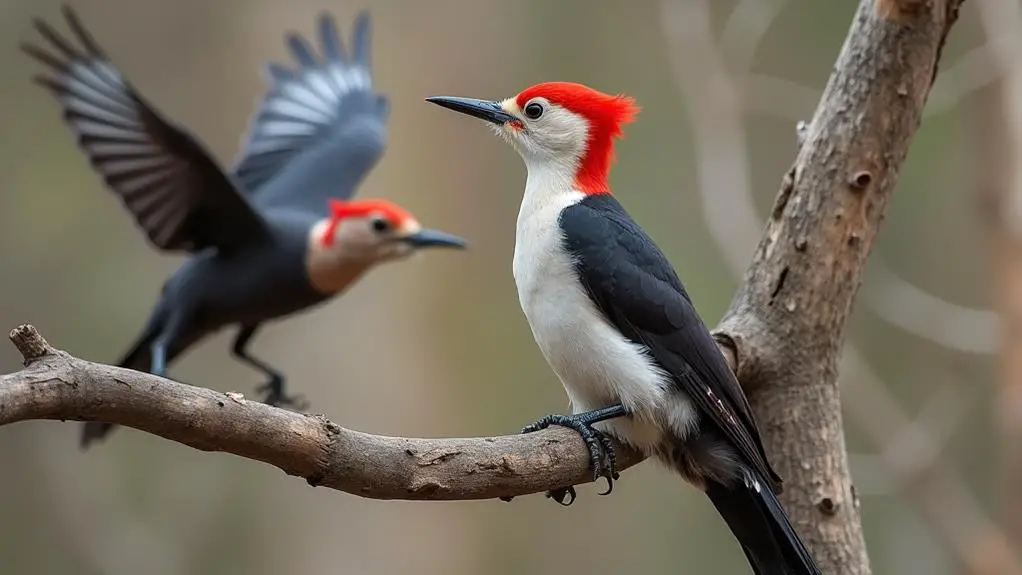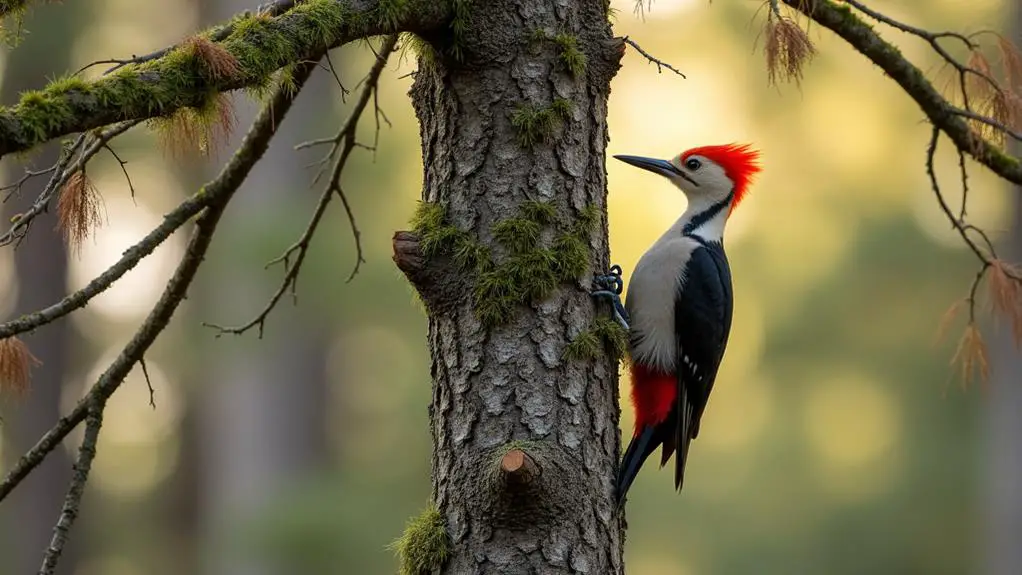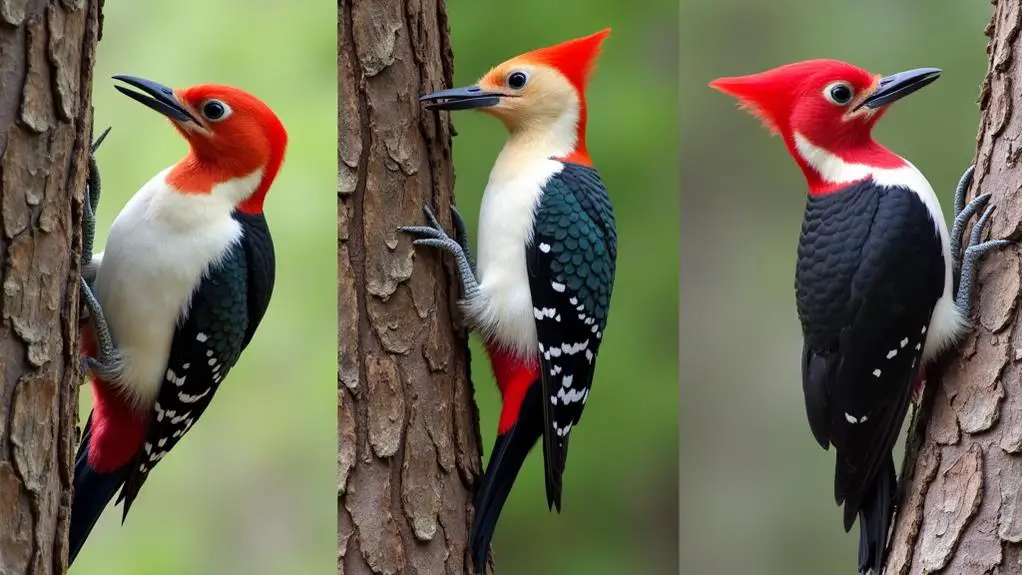If you're an avid birdwatcher or simply enjoy spending time outdoors in Georgia, you've likely caught a glimpse of a woodpecker or two. But with over 20 species in the state, it can be tough to keep track of who's who. Three species, in particular, stand out for their unique characteristics and habits. You might've spotted the Red-headed Woodpecker's striking red cap, or heard the Pileated Woodpecker's loud drumming beats on trees. But what sets these birds apart, and how can you tell them from one another? Let's take a closer look at what makes each of these species special.
Key Takeaways
- Georgia is home to the Red-headed, Pileated, and Red-bellied woodpeckers, each with distinct characteristics and habitats.
- The Red-headed Woodpecker is a year-round resident, recognized by its striking red cap, black back, and white underside.
- Pileated Woodpeckers are the largest in Georgia, growing up to 19 inches in length, with a distinctive red crest and black and white striped face.
- The Red-bellied Woodpecker is adaptable and can be found in various forest dwellings, including urban and suburban areas.
- These three species can be identified by their unique calls, such as the Red-headed Woodpecker's "tchek" or "kreee," and the Pileated's drumming beats.
Red-headed Woodpecker Profile

The Red-headed Woodpecker, a medium-sized woodpecker with a distinctive red cap, is a year-round resident in Georgia, and you can spot it in open woodlands, savannas, and urban areas with trees.
This species is known for its striking appearance, with a red head, black back, and white underside.
When identifying the Red-headed Woodpecker, you'll notice its loud, sharp calls, often described as a "tchek" or "kreee."
These woodpecker calls can be heard year-round, particularly during breeding season.
Red-headed Woodpeckers are cavity-nesting birds, and you'll often find them excavating nesting sites in dead trees or snags.
Their nesting habits typically involve both males and females excavating the site, with the female laying 2-5 eggs.
The incubation period lasts around 12-14 days, and both parents take turns caring for the young.
You can spot Red-headed Woodpeckers in areas with dead trees, as they rely on these structures for nesting and foraging.
Pileated Woodpecker Characteristics
Pileated Woodpeckers are the largest woodpeckers in Georgia, with their impressive size often making them stand out in the state's woodlands.
These birds can grow up to 19 inches in length and weigh up to 16 ounces, making them a sight to behold. You'll recognize them by their distinctive red crest and black and white striped face.
When it comes to identifying Pileated Woodpeckers, you can listen for their unique woodpecker calls, which sound like loud, drumming beats on trees.
They also make a series of loud "kuk-kuk-kuk" calls, often used for communication. Their foraging techniques are also notable, as they use their powerful beaks to excavate insects and sap from trees.
They'll often create large cavities in trees, which can be up to 16 inches deep.
Their foraging activities can be a great way to spot these birds, as they'll often drum on trees to create holes.
You can also look for their distinctive nests, which are often located in large tree cavities. By paying attention to these characteristics, you can increase your chances of spotting a Pileated Woodpecker in Georgia's woodlands.
Red-bellied Woodpecker Habits

Now that you've learned to identify Pileated Woodpeckers in Georgia, it's time to turn your attention to another common species: the Red-bellied Woodpecker. As you observe these birds, you'll notice their unique habits and characteristics. Red-bellied Woodpeckers are known for their adaptability to various forest dwellings, including urban and suburban areas.
| Behavior | Frequency | Importance |
|---|---|---|
| Foraging for insects | Daily | Essential for survival |
| Visiting bird feeders | Regularly | Supplements their diet |
| Drumming on trees | Seasonally | Establishes territory |
| Nesting in cavities | Annually | Crucial for reproduction |
| Roosting in tree holes | Year-round | Provides protection |
Their woodpecker diets consist mainly of insects, sap, and fruits. In the forest, they forage for insects in trees and on the ground, making them an essential part of the ecosystem. As you explore Georgia's woodlands, keep an eye out for Red-bellied Woodpeckers, and observe their fascinating habits up close.
Frequently Asked Questions
Are Woodpeckers in Georgia Protected by Law?
You'll find that woodpeckers in Georgia are protected by both Federal regulations and State laws. The Migratory Bird Treaty Act and Georgia's Wildlife Conservation Code regulate the treatment and management of woodpeckers and their habitats.
Do Woodpeckers Eat Insects During Winter Months?
You'll find that woodpeckers adapt to winter by relying on stored fat reserves and cached food, but they still forage for insects during winter months, using cold storage sites to retrieve previously cached invertebrates for sustenance.
Can Woodpeckers Cause Damage to Trees?
As you ponder the impact of woodpeckers, consider this: like a double-edged axe, their actions can both harm and help. You may inadvertently cause tree decay by attracting woodpeckers, which can lead to bark damage.
How Do Woodpeckers Choose Their Mates?
You'll find that woodpeckers choose their mates based on visual cues, such as brightly colored plumage and distinctive markings. They also engage in drumming rituals, where they drum on trees to attract a suitable partner.
Can Woodpeckers Be Kept as Pets?
You're considering pet ownership, but woodpeckers aren't ideal pets due to complex social and spatial needs. Providing adequate woodpecker care is challenging, requiring large, escape-proof enclosures and specialized diets, making them difficult to keep as pets.
Conclusion
You've now got the lowdown on Georgia's three standout woodpeckers. Each species brings its unique charm to the table, whether it's the Red-headed Woodpecker's striking red cap, the Pileated Woodpecker's thunderous drumming, or the Red-bellied Woodpecker's adaptable nature. By familiarizing yourself with these birds, you'll be "drilling down" to the heart of Georgia's woodpecker scene. Take this knowledge outdoors and see if you can spot these fascinating birds in their natural habitats.





